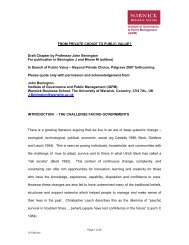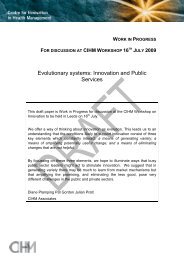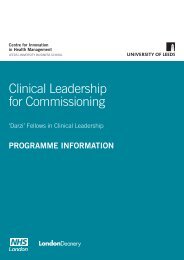Networks - a briefing paper for the Health Foundation - Centre for ...
Networks - a briefing paper for the Health Foundation - Centre for ...
Networks - a briefing paper for the Health Foundation - Centre for ...
- No tags were found...
You also want an ePaper? Increase the reach of your titles
YUMPU automatically turns print PDFs into web optimized ePapers that Google loves.
2 Types of <strong>Health</strong> <strong>Networks</strong>A grounded <strong>the</strong>oretical approach was undertaken by CIHM which identified six over-archingnetwork areas (health care and beyond), which was <strong>the</strong>n explored within <strong>the</strong> academicliterature. Fur<strong>the</strong>r research has illuminated six broad categories. Section 2.1: Managed Hierarchical <strong>Networks</strong> Section 2.2: Developmental <strong>Networks</strong>, Section 2.2.1: Two sub-types ofDevelopmental <strong>Networks</strong> (Co-ordinating <strong>Networks</strong> and Individual Procurement<strong>Networks</strong>)Section 2.3: Social <strong>Networks</strong>/Media.Section 2.4 Agency <strong>Networks</strong>/ Policy <strong>Networks</strong>; Sections 2.4.1 and 2.4.2 NAAPS andTower Hamlets case studies Section 2.5 Learning <strong>Networks</strong> 2.5.1 Communities of Practice; 2.5.2 EpistemicCommunities 2.5.3 Support <strong>Networks</strong> 2.5.4 Enclave <strong>Networks</strong> / Individual <strong>Networks</strong>;2.5.4.1: three types of Enclave <strong>Networks</strong>Section 2.6 Advocacy <strong>Networks</strong>; Section 2.6.1 Transnational Action <strong>Networks</strong>2.1 Managed <strong>Networks</strong>Evaluation of managed clinical networks with summary list in Section 3.3.5Characteristics: Traditional Model; Mandated work; Hierarchical; Clear Allocation ofLabour; Competency (<strong>for</strong> creating pre-specified tasks)Leadership: Transactional; Autocratic / Hierarchical Leadership; Central leadershipmust translate vision into strategy and strategy into operational actions.Governance: Hub and Spoke Governance Structure: Not particularly network-centricor organization-centric. No distinct corporate shape but definitely has a top-downstructure and fails to offer anything unique in comparison to o<strong>the</strong>r network <strong>for</strong>mswhich are more fluid and undefined.Failure: Authorized networks have a history of ineffectiveness because networkmembers may not recognize <strong>the</strong> authority required <strong>for</strong> <strong>the</strong>ir governance. Hub-and –spoke centralized networks must decentralise communications; outer layers unable toengage in meaningful discussion; hub and spoke structure is constrained if aneffective (high functioning and successful) leader leaves his postThe key characteristics of managed networks, such as those that result from policyinitiatives(Evaluation of managed networks in Section 3.3.2), often include <strong>the</strong> use of a <strong>for</strong>umand <strong>for</strong>mal management structures. Governance is unambiguous and clearly defined, and<strong>the</strong> hub has clear authority and power to regulate its members or member’s organisations(Mendizabal and Hearn, 2011). Arrangements <strong>for</strong> external accountability and targetedobjectives are linked to a written and agreed strategy, and <strong>the</strong>y often consist of a: ‘...directsteering group and often accredit or inspect providers, specify requirements and manage atask to deliver change. This might be a contract with <strong>the</strong> responsibility of agreeing itsspecification and reducing transaction costs, or an agreement to produce a binding protocolor remodel a service. They have a dedicated manager and ei<strong>the</strong>r budgets to manage or defacto determination of <strong>the</strong> use of budgets held by a host organisation’ (Harris, 2005: n.p). Thebenefits of managed networks include greater competency <strong>for</strong> completing pre-specified tasksand clarifying <strong>the</strong> division-of-labour element across different individuals/organisations.23
















